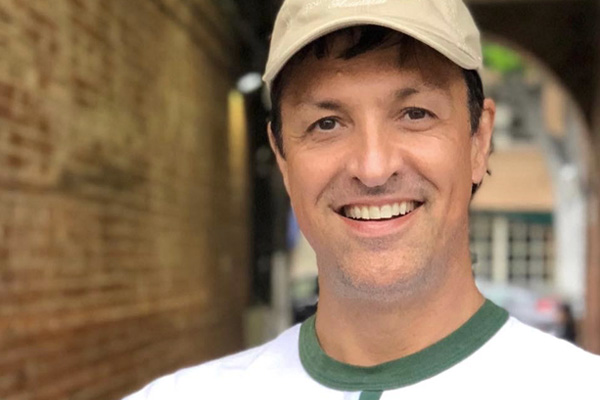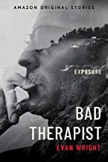Disclaimer: The opinions, beliefs and viewpoints expressed in the following article does not necessarily reflect the opinions, beliefs and viewpoints of the Addiction/Recovery eBulletin or official policies of the Addiction/Recovery eBulletin.
July 21, 2020 By John Lavitt

When Cliff Brodsky, a successful music producer and songwriter, first met now-imprisoned rehab mogul Christopher Bathum at a 12-Step meeting in 2011, he did not realize he was coming face-to-face with a monster. Indeed, Bathum, a practicing psychotherapist and published author, had a way of charming everyone. With a seemingly model SoCal family of a former actress wife and three lovely daughters, Bathum easily sucked smart and successful people in recovery into his web of lies and deceit. Like so many others, Cliff Brodsky became entangled.
Nobody realized that Bathum, who owned and operated Community Recovery of Los Angeles and other entities in Southern California and Colorado, would later be sentenced to over fifty years in prison. He was found guilty of sexually assaulting vulnerable female patients in his facilities after providing them with drugs.
In February 2018, L.A. County jurors found Bathum guilty of 31 counts, including forcible rape, sexual penetration by a foreign object, forcible oral copulation, and sexual exploitation. In a separate case, he later was found guilty of running a $175 million healthcare billing scam out of those same recovery ventures.
Frustratingly, Cliff Brodsky was hurt not only by Bathum but also by a journalist covering the story. In Bad Therapist, a new exposure book only available through Amazon, Evan Wright of Generation Kill fame twisted Brodsky’s account of what happened into a false narrative. Moreover, Wright misquoted Brodsky time and time again, making him look like a foolish opportunist. For example, in the book, Wright claims, “Brodsky offered Bathum a million dollars on the spot” upon meeting him without doing any due diligence.
Nothing could be further from the truth. Brodsky only invested half a million dollars in Bathum’s Walking Miracles when he learned that noted therapist and old friend Thomas Hedlund was working as Bathum’s clinical director. Brodsky and Hedlund had a long history of being mentored by that late John Bradshaw, a well-known motivational speaker who hosted PBS television programs on addiction, codependency, and spirituality. Thus, Brodsky thought his investment with Bathum was solid.
Moreover, other significant voices and players in the recovery industry, who would prefer their names not be mentioned, vouched for Bathum. It’s hard to understand why Evan Wright would turn his sights on a victim like Cliff Brodsky. Then again, the whole tale overflows with ugliness; a sordid mess of corruption, and downright evil. According to Brodsky, his attempt to take down Bathum unraveled his life, leading to death threats and false accusations. Thus, he often sounds like an innocent man trying to keep his head above toxic waters. Once wealthy and successful, Brodsky was forced to file for Chapter 11 bankruptcy in 2012, sinking into a battle to find justice for himself and Bathum’s other victims. Hoping to do good, an optimistic dude got dragged into Bathum’s sordid abyss.

Digging Deeper — Five Questions with Cliff Brodsky
John Lavitt: Can you tell us how you first met Christopher Bathum, and why you chose to invest in his business ventures? Half a million dollars is a lot of money.
Cliff Brodsky: Yup. I met him through a person at a 12-Step meeting in Los Angeles when I was looking to do some philanthropic work in the recovery community. She recommended Chris Bathum, and he seemed like a nice guy at first. When he gave me a tour of Walking Miracles, one of the facilities that he said was looking for investors, everything seemed on the level. Good people were living in the facility, getting better, and they had a cook and a dog running around.
I also met his wife and his family, and they all came across as regular folks. In the beginning, there were no red flags. There were no indications that this guy was a crystal meth-addicted cross between Bill Cosby and Bernie Madoff.
A little bit later, I realized that Bathum was working with Thomas Hedlund as a Clinical Director, who I had met during the workshops I had taken with John Bradshaw. If Thomas Hedlund was good enough for Bradshaw, then that made me trust him. I also had a friend who worked on Wall Street look into it. He checked out the financials and gave me the thumbs up. Everyone I spoke with gave me the thumbs up about this guy.
After two weeks, I said to Bathum, “Let’s do this!” I invested $250,000 for a 5% stake, then doubled down on the investment for another $250,000 to raise my stake to 10%. It seemed like a smart investment at the time on many different levels.
Even with all those endorsements, maybe I was foolish to invest in the first place, maybe I was a bit of a Pollyanna. I thought to invest in recovery was a beautiful thing; let’s give back by giving three hots and a cot to these people in need. It felt in my heart like a great move to make at the time.
John Lavitt: When did you realize that something was wrong?
Cliff Brodsky: Quite frankly, I knew something was wrong before I invested. I knew there was something off with him, but I tend to be fascinated with eccentric, kooky types. I had a sense that he was eccentric and kooky, but it didn’t seem like in a bad way. Plus, all these people were vouching for him, including Tom Hedlund. If he has Tom Hedlund on his team, then it must be the real deal.
I was in for a rude awakening. You have to realize that I thought I had invested in this nice rehab facility, the place that Bathum had shown me, but I later learned I had invested in a flophouse in Koreatown with nothing more than a person answering the phone. Bathum had shown me a fake rehab with fraudulent advertisements to draw me into his schemes. The whole thing that I had seen in the beginning had felt like a movie.
Before I discovered this truth, however, the first real red flag was when my first check from Bathum bounced six weeks after I had given him the money. Bathum blamed the guys at the office, but I knew something was wrong. He was so good at skirting responsibility and downplaying what was happening. I couldn’t believe it. After giving you $500,000 in cash, you bounce my first check?! It seemed so absurd. Years later, after doing a forensic accounting of the money with a bankruptcy attorney, I learned that Bathum started the process of stealing the money on day one. He was siphoning it laterally through shell companies.
Later, it got so much worse when I found out that he was drugging and raping female clients. It was hard to fathom. Rather than just a scoundrel with money, I realized I had become involved with a crystal meth-addicted villain, who was committing unspeakable crimes. In his rehabs, he gave crystal meth, heroin, and prescription drugs to female clients so he could have his way with them.
John Lavitt: Once you realized the extent of his transgressions, what happened next?
Cliff Brodsky: I realized my fight against Bathum was so much more than just my ego being bruised. So many others had been hurt as well, and many of them were victims of criminal acts that often lead to lifelong traumatic damage. When I won my lawsuit against Bathum and got a big judgment, it was a frustrating victory because Bathum was arrested soon after. I never would see the money again, but, at the very least, I had helped get a truly evil man off the streets.
Also, once I took this man on, Bathum became vengeful. As he expanded his criminal undertakings, the disease of his soul progressed. He became more unstable and more dangerous. Bathum made countless death threats against me, and people warned me about his capacity for violence. I knew I was doing the right thing, but I felt like a man under siege.
I also kept thinking about how this should never have happened. I could have invested in widgets or plastics or pork bellies. Some of my best qualities had been turned against me. I wanted to be of service to the Southern California recovery community in a more profound and meaningful way, and I got hustled by a hustler. Chris Bathum was a shark, smelling blood in the water, but the blood in the water was my optimism and my desire to do good in the world.
John Lavitt: When “Bad Therapist” by Evan Wright came out, things got worse. Critical of Bathum, it strangely justified his behavior. How did this affect you?
Cliff Brodsky: It was a bizarre part of this journey because Evan Wright seemed so nice when I first met him. He was soft-spoken, polite, and he allowed me to finish my thoughts without interrupting. He had the perfect smooth bedside manner for a guy with PTSD symptoms like me. He listened in what felt like a really supportive way, but, little did I know, he was setting me up to take the fall. He seemed to want Bathum to get a mistrial by blaming it on me. It felt like Evan Wright had come up with this crazy scheme while interviewing Bathum in jail and possibly even working for him. Why would a journalist suddenly want to be Chris Bathum’s get-out-of-jail free card?
I don’t know whether or not he was working with or for Bathum, but it seemed that way by the end. He was willing to free a monster just to crucify other people and expand the narrative. He blew up the truth, maybe even lying intentionally, to make the scandal seem worse and more extreme. You would think Christopher Bathum would be enough, but he wanted more bad guys.
On his Wikipedia page, it says that Wright’s whole journalistic approach is to charm and betray. Well, when I was very vulnerable, and I already had been hurt by Bathum, he did just that. After fostering an atmosphere where I finally could relax and let my guard down, he warped whatever I said, then used it as a misguided weapon against me. I became the bad guy and Bathum was the victim. It was so far off base.
Evan Wright charmed, then he betrayed while adding falsehoods. He painted a picture that made it look like I was at the center of a massive conspiracy against Bathum. Right after interviewing me, a motion to dismiss Bathum’s convictions was filed based on these falsehoods. He tried to use my interviews as a basis to get Bathum a mistrial. Luckily, the Judge saw right through that bullshit, and the conviction stood.
John Lavitt: Now that Bathum is behind bars, do you still feel threatened? More importantly, how do you recover your bearings and move on with your life?
Cliff Brodsky: Honestly, I haven’t gotten that far yet. This case has been consuming me for nine years, and now I feel a sense of vertigo. I want to be grounded, but where is the ground? Sometimes I’m not sure what’s valid anymore, and I don’t know who to believe. So much of my Pollyanna innocence, my faith in people and my desire to do good, has been stained by this experience.
During the craziness of COVID-19, the best I can do to find my bearings is to sit down at my piano. I want to put this behind me and get back to my roots as a musician. Playing music, producing artists, and finishing my solo record is my solace, a kind of creative consolation that no one can take away from me. It’s been the answer from day one, and it’s still the answer. It saved me before, and it will save me again.
So what happens next? Maybe the women abused and traumatized by Bathum will recover. Maybe people will be less willing to invest in recovery ventures when red flags are waving like the finish line of the Indy 500. Most importantly, Christopher Bathum stays behind bars for the rest of his life. But the damage has been done. When it comes down to the brass tacks, do any of these scandals ever end well? When toxic personalities pollute principles, a happy ending is the stuff of fairy tales and not reality.
Available Free to Amazon Prime members:

Bad Therapist – Kindle Edition
Order from Amazon

I Found God in Hollywood by Cliff Brodsky
Order from Amazon
Disclaimer: The opinions, beliefs and viewpoints expressed in the above article does not necessarily reflect the opinions, beliefs and viewpoints of the Addiction/Recovery eBulletin or official policies of the Addiction/Recovery eBulletin.


